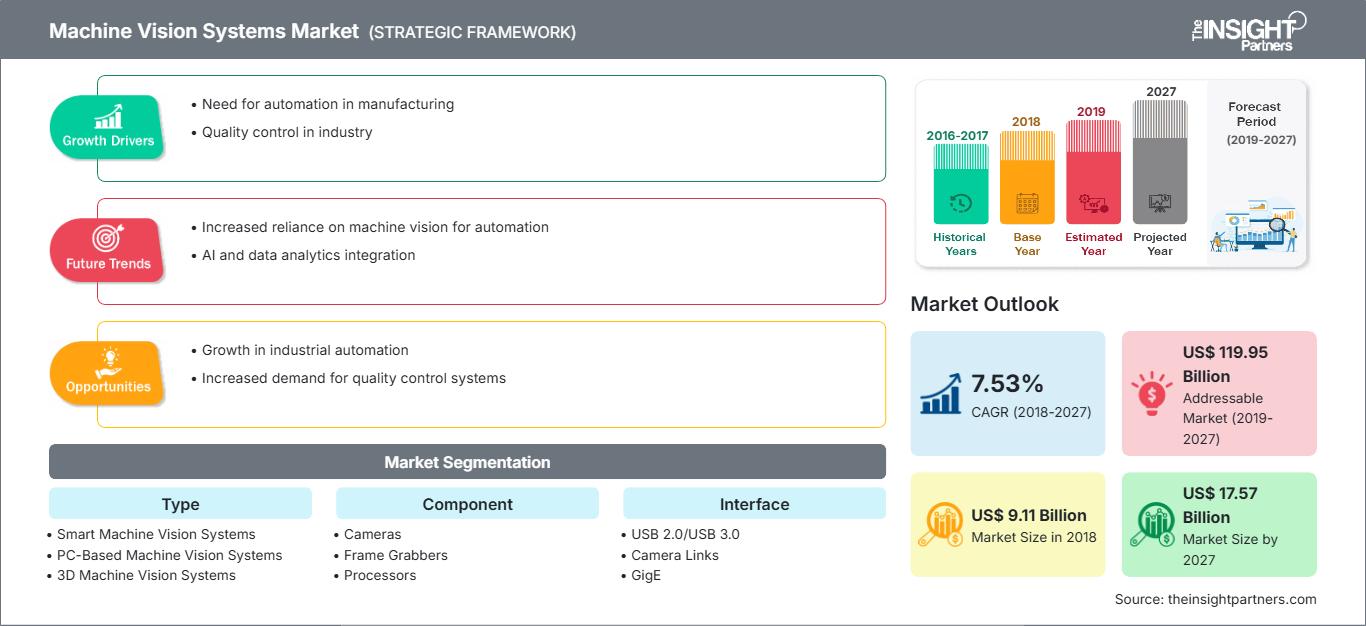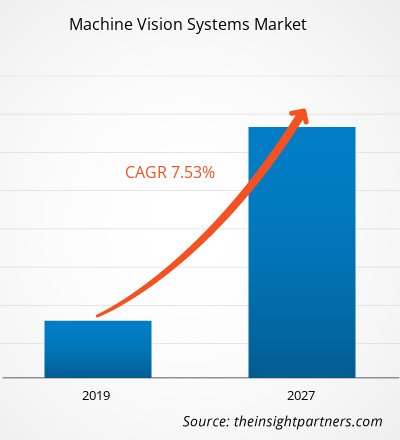The machine vision systems market was valued at US$ 9.11 Bn in 2018 and is projected to reach US$ 17.57 Bn by 2027; it is expected to grow at a CAGR of 7.53% from 2019 to 2027.
Machine Vision Systems are the next generation intelligent systems mainly used in industrial applications for detection, identification, measurement, inspection and so on. These systems play major roles in robotics; these are used to guide the autonomous robots also known as ‘self-navigating robots’. Various industries such as automotive, food & beverage, pharmaceuticals are much concerned about reducing labor intensive processes, increasing accuracy and speed; machine vision systems are in demand to overcome these concerns. Machine vision systems can perform complex repetitive tasks with higher accuracy and consistency. Machine vision systems include components such as image sensors, processors, PLC, frame grabbers and more, which are driven by a software package to execute user defined applications. Machine vision systems are also employed in non-inspection applications such as guiding robots, pick and place the parts, dispensing liquids and many more. Machine vision and components market is expected to experience significant growth in the coming years due to the increasing demand in industries such as automation, robotics and non–manufacturing which include intelligent transport system, logistics and medical, exhibiting substantial market growth. Machine vision systems are classified into three types, namely: Smart Vision Systems, PC-Based Vision Systems and 3D Vision Systems. Machine vision systems has set the highest growth record in North America in 2018. Whereas, Europe is the major manufacturer and exporter of these systems worldwide. Manufacturing industry is the largest end-user of these systems however, the growth of machine vision systems in non- industrial niche applications such as logistics, intelligent traffic systems, IP video surveillance, and others is also rising owing to ongoing improvements in the technology resulting in decreasing the costs of these systems.
The North America and Europe in total holds more than half of the overall market share, while the regions such as APAC, MEA, and SAM are exhibiting a high growth rate due to various factors such as increase advancements in technology and rise in the lifestyles of individuals in developed as well as developing countries of the world. Implementations of machine vision systems is expected to accelerate at a high growth rate in the coming few years due to technology, increasing progress of the capabilities of cameras and microprocessors, automotive and other industry verticals’ inclination towards implementing such solutions which can provide better efficiency, easy capacity expansion and optimized CAPEX. Many small and large organizations and enterprises in the above verticals have implemented machine vision systems solutions owing to the various advantages it offers, thus influencing the market revenues and growth rates globally. The growing industrialization, fast population growth and positive economic outlook of developing regions are some of the major factor that are anticipate to drive the growth of machine vision systems market in these regions. Developing countries such as China and India are expected to offer ample growth opportunities for the machine vision systems market players during the forecast period. Due to positive initiatives of policymakers and regulators in various developing countries to support manufacturing and promote industrial growth. The recent strategic initiatives such as “Made in China 2025 Initiative,” by China and “Make in India” by India are examples of such initiatives that are focused on boosting manufacturing sector and industrialization in these countries. The machine vision systems market has experienced high growth and implementations in the last few years and is also expected to experience a significant growth in years to come. One of the major reason for higher implementations of machine vision systems by various industry verticals is, the advancements in several related technologies taking place around the machine vision systems. Computer interfaces, the microprocessors and cameras, all these tools have evolved into highly capable and flexible tools/ components. The advances in technology have thus facilitated mass production and custom manufacturing of suppliers. Machine vision systems also provides end users with improved productivity and quality in the manufacturing process which also helps in achieving higher productivity along with increased profit margins.
Customize This Report To Suit Your Requirement
You will get customization on any report - free of charge - including parts of this report, or country-level analysis, Excel Data pack, as well as avail great offers and discounts for start-ups & universities
Machine Vision Systems Market: Strategic Insights

-
Get Top Key Market Trends of this report.This FREE sample will include data analysis, ranging from market trends to estimates and forecasts.
Market Insights
Government initiatives worldwide to support the growth of manufacturing sector
For a sustainable economic development, countries are increasingly focusing on boosting industrialization, especially in the manufacturing and process industries. Governments of various countries, especially India and China, are taking initiatives through regulations, innovation promotion, and knowledge brokerage to achieve inclusive and sustainable industrialization. The rapidly changing technology landscape in the manufacturing and process industries worldwide has also been encouraging the manufacturing companies to invest in advanced systems and processes, which can help achieve high operational efficiencies and also enable companies to meet challenging demands of today’s customers. The present century is characterized by tough competition in all major industry verticals. The manufacturers of various systems are facing tough competition on parameters such as costs, quality, technology, service, and time-to-market. Thus, to maintain market position and to achieve sustainable development, manufacturers are increasingly investing in advanced systems.
Type-Based Market Insights
On the basis of type, the global machine vision systems market is bifurcated into smart machine vision systems, PC-based vision systems and 3D machine vision systems. Machine vision systems are amalgamation of computer vision into industrial manufacturing processes. Machine vision make use of industrial image processing by using cameras which are placed over production lines and cells with the intention to visually examine, inspect products and control robots in real time without human intervention. Machine vision is also known as industrial vision and comprises of several cameras for capturing, interpreting and motioning individually with a control system connected to some pre-determined standards.
Component -Based Market Insights
On the basis of component, the global machine vision systems market is segmented into cameras, frame grabbers, processors, illuminations & optics, vision software, and others. A machine vision system works tirelessly performing 100%, resulting in improved product quality, increasing yields and reducing production cost. A machine vision system involves many critical components such as sensor (camera), processor, lens, lightings, and frame grabbers. Every machine vision system is reliable on these critical components for better results. The form of components varies with different types of machine vision systems. For example, PC-Based vision systems would require these components discretely; whereas, a smart camera vision system will have these components integrated in one module. Machine vision components play a vital role in every industry wherein machine vision systems are deployed.
Product development is the commonly adopted strategy by companies to expand their product portfolio. Basler AG, IDS Imaging Development Systems GmbH, Omron Microscan Systems, Inc., COGNEX CORPORATION, Keyence Corporation, Teledyne Technologies Incorporated, Datalogic S.p.A, FLIR Systems, Inc., ISRA VISION AG, and OmniVision Technologies, Inc., among others are the key players implementing strategies to enlarge the customer base and gain significant share in the global Machine Vision Systems market, which in turn permits them to maintain their brand name. A few of the recent key developments are:
- In 2018, Datalogic opened new office at Las Colinas, in the Dallas area. This office is aimed at serving as a business development hub for the North America Market. The new team is responsible for generating new leads based on interest, converting those into sales opportunities. In addition, Application engineers support the sales team in demo activities on specific products across all verticals in which Datalogic operates, to present advanced Datalogic solutions to prospective customers.
- In 2019, Cognex Acquired SUALAB in order to advance its leadership in deep learning-based machine vision. The acquisition of SUALAB’s intellectual property and engineering team is anticipated to enhance Cognex’s existing deep learning competences based on technology that was acquired from ViDi Systems in April 2017.
The regional trends and factors influencing the Machine Vision Systems Market throughout the forecast period have been thoroughly explained by the analysts at The Insight Partners. This section also discusses Machine Vision Systems Market segments and geography across North America, Europe, Asia Pacific, Middle East and Africa, and South and Central America.
Machine Vision Systems Market Report Scope
| Report Attribute | Details |
|---|---|
| Market size in 2018 | US$ 9.11 Billion |
| Market Size by 2027 | US$ 17.57 Billion |
| Global CAGR (2018 - 2027) | 7.53% |
| Historical Data | 2016-2017 |
| Forecast period | 2019-2027 |
| Segments Covered |
By Type
|
| Regions and Countries Covered |
North America
|
| Market leaders and key company profiles |
|
Machine Vision Systems Market Players Density: Understanding Its Impact on Business Dynamics
The Machine Vision Systems Market is growing rapidly, driven by increasing end-user demand due to factors such as evolving consumer preferences, technological advancements, and greater awareness of the product's benefits. As demand rises, businesses are expanding their offerings, innovating to meet consumer needs, and capitalizing on emerging trends, which further fuels market growth.

- Get the Machine Vision Systems Market top key players overview
Machine Vision Systems Market Segmentation:
By Type
- Smart Machine Vision Systems
- PC-Based Machine Vision Systems
- 3D Machine Vision Systems
By Components
- Cameras
- Frame Grabbers
- Processors
- Illuminations & Optics
- Vision Software
- Vision Sensors
- Others
By Interface
- USB 2.0/USB 3.0
- Camera Links
- GigE
- CoaXPress
- Others
By End Users
- Automotive
- Electronics & Semiconductor
- Food & Beverages
- Pharmaceuticals
- Logistics
- Others
Company Profiles
- Basler AG
- IDS Imaging Development Systems GmbH
- Omron Microscan Systems, Inc.
- COGNEX CORPORATION
- Keyence Corporation
- Teledyne Technologies Incorporated
- Datalogic S.p.A
- FLIR Systems, Inc.
- ISRA VISION AG
- OmniVision Technologies, Inc.
Frequently Asked Questions
Which system type is most commonly used for Machine Vision?
What are market opportunities for Machine Vision Systems?
What are reasons behind European Machine Vision Systems industry growth?
- Historical Analysis (2 Years), Base Year, Forecast (7 Years) with CAGR
- PEST and SWOT Analysis
- Market Size Value / Volume - Global, Regional, Country
- Industry and Competitive Landscape
- Excel Dataset
Recent Reports
Related Reports
Testimonials
Reason to Buy
- Informed Decision-Making
- Understanding Market Dynamics
- Competitive Analysis
- Identifying Emerging Markets
- Customer Insights
- Market Forecasts
- Risk Mitigation
- Boosting Operational Efficiency
- Strategic Planning
- Investment Justification
- Tracking Industry Innovations
- Aligning with Regulatory Trends





















 Get Free Sample For
Get Free Sample For